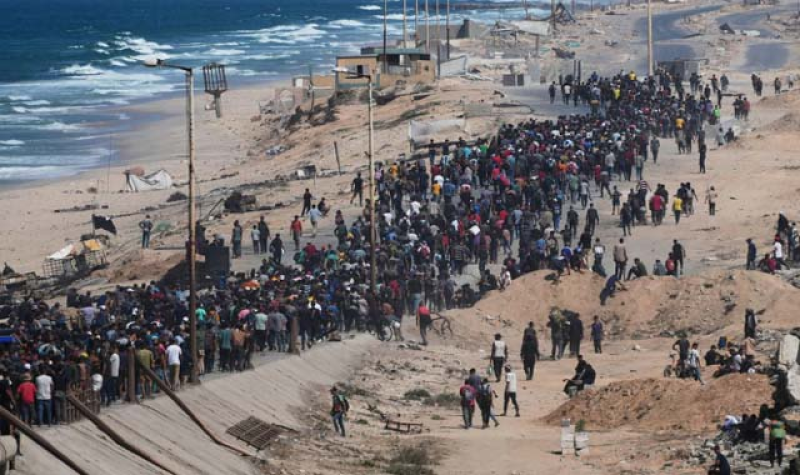- Govt to cut savings certificate profit rates from January |
- Gold prices hit fresh record in Bangladesh within 24 hours |
- Election to be held on time, Prof Yunus tells US Special Envoy |
- Moscow wants Dhaka to reduce tensions domestically, also with Delhi |
- Saarc experts meet to reduce livestock-origin greenhouse gases |
Thousands Return to Ruins as Gaza Ceasefire Brings Hope

Thousands Return to Ruins as Gaza Ceasefire Brings Hope
Tens of thousands of Palestinians began returning to the devastated northern Gaza Strip on Friday as a U.S.-brokered ceasefire took effect, offering the first real hope for peace after nearly two years of war. Under the deal, all remaining hostages are expected to be freed within days.
Questions remain over Gaza’s future governance as Israeli forces begin to pull back, and whether Hamas will disarm as outlined in U.S. President Donald Trump’s ceasefire framework. Israeli Prime Minister Benjamin Netanyahu, who previously ended a truce in March, warned that Israel could resume operations if Hamas refuses to lay down its arms.
The ceasefire marks a crucial step toward ending a brutal war that began with Hamas’ surprise attack on Israel in October 2023. The conflict has killed tens of thousands of Palestinians and displaced about 90% of Gaza’s two million residents. Many of them are now returning to find their homes reduced to rubble.
The Israeli military confirmed the start of the truce on Friday, saying 48 hostages — about 20 believed to be alive — will be released by Monday. Palestinians reported that heavy shelling subsided across Gaza shortly after the announcement.
In a televised address, Netanyahu said Gaza must be demilitarized. “If this can be achieved the easy way, so be it. If not, it will be achieved the hard way,” he declared. The military said it would maintain a “defensive presence” in about half of Gaza while withdrawing from key areas.
UN Prepares Major Aid Delivery
The United Nations received approval from Israel to begin large-scale humanitarian deliveries into Gaza starting Sunday. A UN official said the shipments would help tackle severe hunger and famine caused by months of fighting and aid restrictions.
The planned delivery includes 170,000 metric tons of food, fuel, and medical supplies stored in Jordan and Egypt. Talks between UN and Israeli officials in Jerusalem finalized logistics and border access.
UN spokesperson Stephane Dujarric said limited supplies had already started entering through the Kerem Shalom crossing. However, humanitarian groups continue to urge Israel to open more routes to ensure safe passage for civilians and aid convoys.
UN humanitarian chief Tom Fletcher noted that, in recent months, only 20% of Gaza’s aid needs were being met.
Scenes of Return and Destruction
A steady stream of displaced Palestinians, many on foot, were seen heading north along Gaza’s coastal road to check what remained of their homes. Others moved south to join relatives in less damaged areas.
“The ceasefire eased our suffering, even if the pain remains,” said Jamal Mesbah, who was displaced from northern Gaza.
In Khan Younis, Fatma Radwan described returning to total devastation. “There was nothing left — only scattered clothes, pots, and wood,” she said, as people searched through debris for belongings and bodies.
Casualties and Humanitarian Toll
The war began on October 7, 2023, when Hamas-led militants stormed into Israel, killing about 1,200 people and taking 251 hostages. Israel’s retaliation killed more than 67,000 Palestinians and injured nearly 170,000, according to Gaza’s Health Ministry. About half of the victims were women and children.
The conflict has inflamed regional tensions, sparked global protests, and led to genocide allegations against Israel — charges it strongly denies.
Hostage and Prisoner Releases
Under the ceasefire terms, Israel will release around 2,000 Palestinian prisoners in exchange for the remaining hostages. The list, made public Friday, excludes popular Palestinian leader Marwan Barghouti.
Hamas official Khalil al-Hayya said all women and children held in Israeli prisons would be freed. Egyptian and Hamas mediators said the releases could start as early as Sunday night.
Relatives of Israeli hostages expressed cautious optimism. “It’s a measured sense of hope,” said Stephen Brisley, whose family members were killed or captured during the October 7 attack.
Trump’s Postwar Framework
Under President Trump’s ceasefire plan, Israel would maintain a long-term military presence along Gaza’s borders, while an international peacekeeping force — mainly from Arab and Muslim countries — would oversee internal security.
The U.S. would lead a major reconstruction effort, with a potential future role for the Palestinian Authority, pending reforms. The proposal, however, remains vague on the issue of Palestinian statehood — something Netanyahu continues to oppose.

